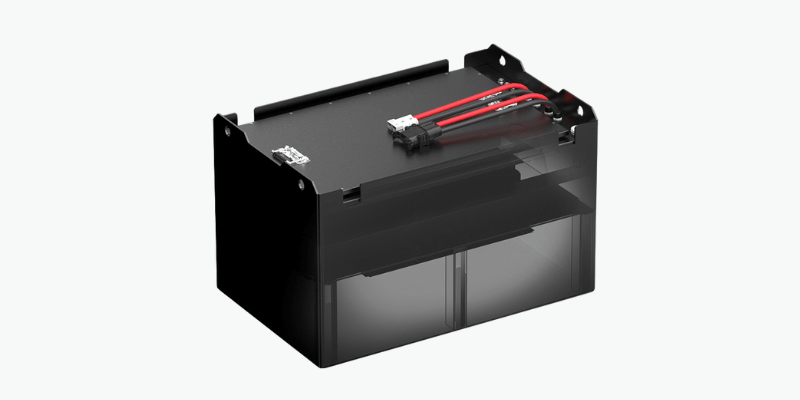Choisir la bonne batterie industrielle est essentiel pour l’efficacité lors de l’utilisation de chariots élévateurs, que ce soit pour un camion ou une flotte. La batterie de chariot élévateur électrique appropriée peut permettre d’économiser du temps et de l’argent à long terme.
Dans cet article, nous aborderons différentes batteries de chariots élévateurs, leurs principales différences et leurs fourchettes de prix.
Types de batteries de chariots élévateurs
Bien que le propane, le diesel et l’essence soient d’autres options, les deux tiers des chariots élévateurs mis en service chaque année sont électriques.
Les chariots élévateurs électriques sont alimentés principalement par deux types de batteries : plomb-acide et lithium-ion.
Le type de batterie affecte la fréquence de remplacement : les batteries lithium-ion peuvent supporter plus de 3 000 cycles, tandis que les batteries au plomb durent environ 1 500 cycles. De plus, les batteries lithium-ion nécessitent un remplacement moins fréquent, ce qui les rend préférables aux batteries au plomb pour de nombreux propriétaires d'entreprise.

Tensions de batterie de chariot élévateur
Les batteries de chariot élévateur sont généralement choisies en fonction de l'équipement de levage et de son utilisation prévue. Il existe quatre options de tension courantes :
- 24 V : convient aux petits équipements de levage électriques tels que les cavaliers d'extrémité, les cavaliers centraux, les gerbeurs à walkie et les transpalettes à walkie.
- 36 V : Conçu pour les équipements électriques de taille moyenne tels que les chariots élévateurs pour allées étroites et les chariots élévateurs à contrepoids debout.
- 48 V : Utilisé pour les gros équipements électriques, notamment les chariots élévateurs à contrepoids.
- 80 V : réservé aux équipements électriques lourds comme les gros chariots élévateurs à contrepoids.
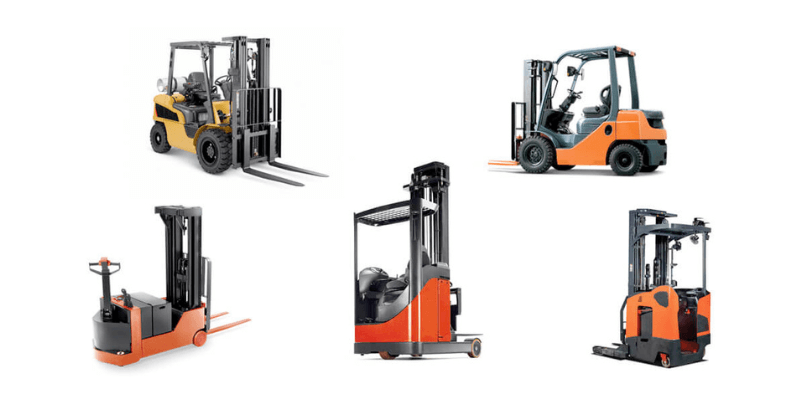
Chargement de la batterie du chariot élévateur
La façon dont la batterie d’un chariot élévateur électrique est rechargée affecte l’efficacité opérationnelle et les besoins en bornes de recharge.
Les batteries lithium-ion se chargent plus rapidement et peuvent être chargées de manière opportune sans avoir besoin d'une recharge complète. En revanche, les batteries au plomb doivent être complètement chargées avant d’être déconnectées et ne peuvent pas être chargées de manière opportuniste.
Les deux types se détériorent s’ils sont mal chargés, mais les unités au plomb ont des directives plus strictes.
Exigences relatives à la station de charge de batterie de chariot élévateur
L'emplacement du système de chargement de batterie de votre chariot élévateur est crucial.
Les batteries au plomb nécessitent des configurations spécifiques, contrairement aux packs lithium-ion. Les batteries lithium-ion peuvent se charger directement dans le chariot élévateur, sans aucune étape supplémentaire nécessaire.
Les batteries au plomb doivent être retirées pour être chargées sur des chargeurs séparés capables d'égalisation. Les entreprises disposant de nombreux chariots élévateurs ont besoin de plusieurs chargeurs et d'un espace pour que les unités refroidissent après la recharge. Ce processus prend du temps, car les employés ont besoin d'un équipement spécial pour gérer régulièrement les changements de batterie.
De plus, les zones de chargement au plomb nécessitent une ventilation adéquate en raison de la chaleur et des fumées nocives produites pendant le chargement. À l’inverse, les batteries lithium-ion peuvent se charger directement dans le chariot élévateur sans nécessiter d’espace dédié ni de périodes de refroidissement. Ils peuvent se recharger immédiatement sur place une fois déchargés.

Système d'arrosage de batterie de chariot élévateur
La charge n’est pas le seul entretien requis pour les batteries au plomb ; leur fluide nécessite une attention régulière.
Contrairement aux batteries lithium-ion scellées, les batteries au plomb nécessitent un système d’arrosage. Les employés doivent apprendre à arroser correctement ces batteries pour garantir des performances et une longévité optimales.
Les pratiques clés pour maintenir l’arrosage des batteries de chariots élévateurs au plomb comprennent :
- Compléter avec de l'eau seulement après avoir été complètement chargé et refroidi.
- Remplissage régulier pour garder le dessus des plaques couvert, généralement tous les 10 cycles de charge.
- Éviter de trop remplir pour permettre l'expansion du liquide pendant l'utilisation.
- Utiliser de l'eau avec un pH compris entre 5 et 7.
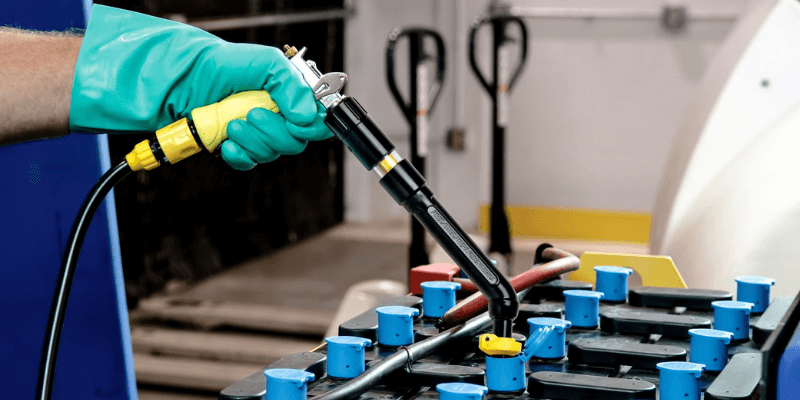
Sécurité des batteries de chariots élévateurs
La sécurité est cruciale lors de la manipulation des batteries de chariots élévateurs en raison des produits chimiques puissants impliqués. Comparons les batteries lithium-ion et plomb-acide en termes de sécurité sur le lieu de travail.
Les risques pour la sécurité des batteries au plomb sont les suivants :
1. Déversements : De l’acide sulfurique peut s’échapper de ces batteries, d’autant plus qu’elles nécessitent un arrosage hebdomadaire. Une mauvaise manipulation augmente les risques pour les employés, nécessitant une station de lavage chimique.
2. Surchauffe : ces batteries peuvent devenir extrêmement chaudes pendant la charge et peuvent laisser échapper des gaz explosifs après une charge maximale, ce qui rend le contrôle de la température essentiel pour la sécurité.
3. Gaz dangereux : Une surcharge peut libérer des gaz toxiques comme du sulfure d'hydrogène, de l'hydrogène et du dioxyde de soufre dans des zones mal ventilées. Une odeur d’œuf pourri indique la présence de sulfure d’hydrogène ; des précautions immédiates doivent être prises. Installez des capteurs de gaz catalytiques LIE standard ou des capteurs électrochimiques dans les salles de chargement pour surveiller les niveaux de gaz.
4. Batteries anciennes ou corrodées : Bien que les nouvelles batteries au plomb présentent un risque minime si elles sont chargées correctement, les batteries anciennes ou corrodées sont dangereuses et doivent être éliminées immédiatement.
Au contraire, les batteries lithium-ion des chariots élévateurs sont scellées, éliminant ainsi les risques de déversements d’acide ou de corrosion.
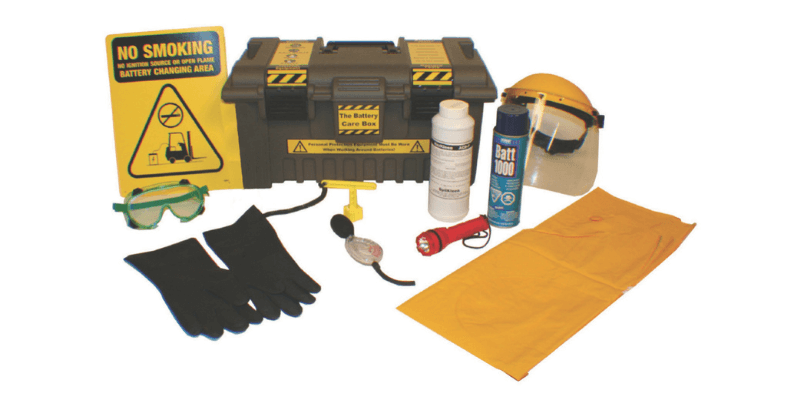
Prix de la batterie du chariot élévateur
Les coûts des batteries de chariots élévateurs varient considérablement selon le type. Une batterie au plomb coûte entre 2 000 et 6 000 dollars, tandis qu'une batterie au lithium coûte entre 17 000 et 20 000 dollars.
Cependant, ces prix ne reflètent pas le coût total de possession (TCO). Les gestionnaires doivent considérer les dépenses à long terme associées à chaque type avant de prendre une décision.
Dans les opérations d’entrepôt, la main-d’œuvre constitue le coût le plus important, mesuré en temps. L'achat de batteries au plomb augmentera les coûts globaux des chariots élévateurs, car elles nécessitent de nombreuses heures de travail pour un fonctionnement correct. Chaque batterie dure environ 8 heures et a besoin de 16 heures pour se charger et se refroidir, ce qui nécessite au moins trois batteries par chariot élévateur pour des opérations 24h/24 et 7j/7. Des batteries supplémentaires sont également nécessaires pour la maintenance, ce qui entraîne davantage de paperasse et une équipe dédiée au suivi.
Les batteries au plomb sont volumineuses et nécessitent un espace de stockage désigné conforme aux lignes directrices du Centre canadien d'hygiène et de sécurité au travail, ce qui entraîne des coûts supplémentaires. Et un équipement spécialisé est nécessaire pour surveiller ces batteries.
De plus, il existe un risque professionnel en raison de leurs liquides corrosifs ; les déversements peuvent interrompre les opérations et entraîner des coûts de temps supplémentaires.
Bien que les coûts initiaux des batteries soient faibles, elles ne durent qu'environ 1 500 cycles avec un entretien approprié, nécessitant un remplacement tous les 2 à 3 ans ainsi que des coûts d'élimination des anciennes unités.
En revanche, une batterie lithium-ion pour chariot élévateur est 55 % plus légère que les batteries au plomb et offre des avantages tels qu'un encombrement réduit, une charge plus rapide, une efficacité énergétique plus élevée, une sécurité améliorée des travailleurs, de meilleures performances à froid et une productivité accrue.
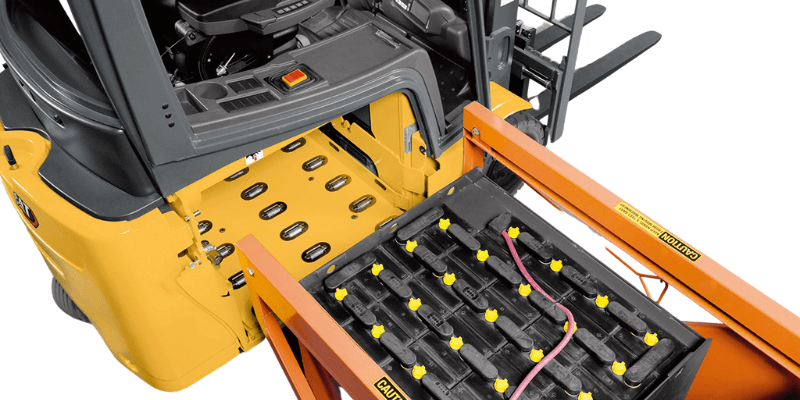
Conclusion
Les batteries lithium-ion, bien qu'initialement plus chères, permettent des économies à long terme grâce à leur efficacité et à une maintenance réduite. Leur charge rapide, leur durabilité et leur sécurité les rendent idéales pour les chariots élévateurs.
Lorsque vous choisissez entre le plomb-acide et le lithium-ion, tenez compte de votre fréquence d'utilisation et de vos besoins en matière de sécurité. Un investissement intelligent dans une batterie augmente la productivité et réduit les temps d'arrêt, aidant ainsi votre entreprise à rester compétitive sur le marché des chariots élévateurs électriques.

